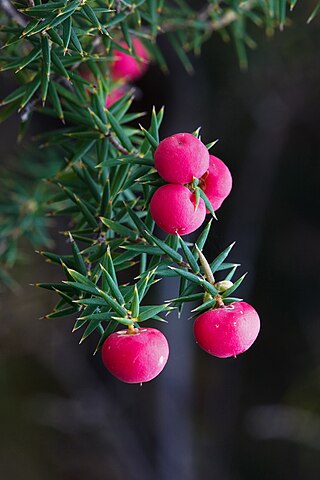
The Ericaceae are a family of flowering plants, commonly known as the heath or heather family, found most commonly in acidic and infertile growing conditions. The family is large, with c. 4250 known species spread across 124 genera, making it the 14th most species-rich family of flowering plants. The many well known and economically important members of the Ericaceae include the cranberry, blueberry, huckleberry, rhododendron, and various common heaths and heathers.

Vaccinium is a common and widespread genus of shrubs or dwarf shrubs in the heath family (Ericaceae). The fruits of many species are eaten by humans and some are of commercial importance, including the cranberry, blueberry, bilberry (whortleberry), lingonberry (cowberry), and huckleberry. Like many other ericaceous plants, they are generally restricted to acidic soils.

Vaccinium vitis-idaea, the lingonberry, partridgeberry, mountain cranberry or cowberry, is a small evergreen shrub in the heath family Ericaceae, that bears edible fruit. It is native to boreal forest and Arctic tundra throughout the Northern Hemisphere, from Europe and Asia to North America. Lingonberries are picked in the wild and used to accompany various dishes, primarily in the Nordic countries. Commercial cultivation is undertaken in the U.S. Pacific Northwest and in the Netherlands.

Bilberries or blueberries are a primarily Eurasian species of low-growing shrubs in the genus Vaccinium, bearing edible, dark blue berries. The species most often referred to is Vaccinium myrtillus L., but there are several other closely related species.

Sabiaceae is a family of flowering plants that were placed in the order Proteales according to the APG IV system. It comprises three genera, Meliosma, Ophiocaryon and Sabia, with 66 known species, native to tropical to warm temperate regions of southern Asia and the Americas. The family has also been called Meliosmaceae Endl., 1841, nom. rej.
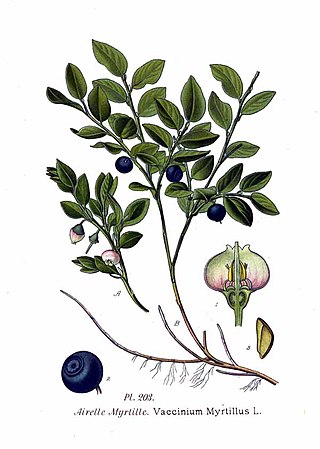
Vaccinium myrtillus or European blueberry is a holarctic species of shrub with edible fruit of blue color, known by the common names bilberry, blaeberry, wimberry, and whortleberry. It is more precisely called common bilberry or blue whortleberry to distinguish it from other Vaccinium relatives.

Oldham's leaf turtle is a species of turtle in the family Geoemydidae.

Vaccinium angustifolium, commonly known as the wild lowbush blueberry, is a species of blueberry native to eastern and central Canada and the northeastern United States, growing as far south as the Great Smoky Mountains and west to the Great Lakes region. Vaccinium angustifolium is the most common species of the commercially used wild blueberries and is considered the "low sweet" berry.

Vaccinium reticulatum, known as ʻōhelo ʻai in Hawaiian, is a species of flowering plant in the heather family, Ericaceae, that is endemic to Hawaii. It grows at altitudes of 640–3,700 m (2,100–12,140 ft) on lava flows and freshly disturbed volcanic ash on Maui and Hawaiʻi, and less commonly on Kauaʻi, Oʻahu, and Molokaʻi. Adaptations to volcanic activity include the ability to survive ash falls of over 25 cm (9.8 in) depth.

Vaccinium uliginosum is a Eurasian and North American flowering plant in the genus Vaccinium within the heath family.

Vaccinium crassifolium, the creeping blueberry, is a species of Vaccinium in the heath family. It is native to the four southeastern U.S. states of Virginia, North Carolina, South Carolina, and Georgia. It is an evergreen shrub with shiny dark green to bronze leaves.
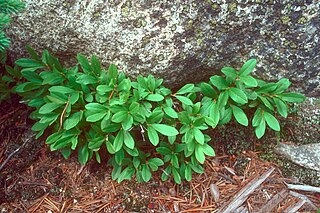
Vaccinium cespitosum, known as the dwarf bilberry, dwarf blueberry, or dwarf huckleberry, is a species of flowering shrub in the genus Vaccinium, which includes blueberries, huckleberries, and cranberries.
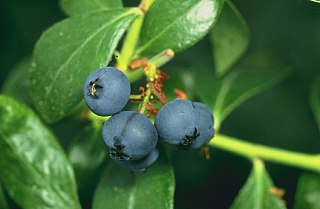
Blueberries are a widely distributed and widespread group of perennial flowering plants with blue or purple berries. They are classified in the section Cyanococcus within the genus Vaccinium. Vaccinium also includes cranberries, bilberries, huckleberries and Madeira blueberries. Commercial blueberries—both wild (lowbush) and cultivated (highbush)—are all native to North America. The highbush varieties were introduced into Europe during the 1930s.

Bambusa oldhamii, known as giant timber bamboo or Oldham's bamboo, is a large species of bamboo. It is the most common and widely grown bamboo in the United States and has been introduced into cultivation around the world. It is densely foliated, growing up to 20 metres tall in good conditions, and can have a diameter of up to 10 centimetres.

Huckleberry is a name used in North America for several plants in the family Ericaceae, in two closely related genera: Vaccinium and Gaylussacia.

Vaccinium pallidum is a species of flowering plant in the heath family known by the common names hillside blueberry, Blue Ridge blueberry, late lowbush blueberry, and early lowbush blueberry. It is native to central Canada (Ontario) and the central and eastern United States plus the Ozarks of Missouri, Arkansas, southeastern Kansas and eastern Oklahoma.

Vaccinium oxycoccos is a species of flowering plant in the heath family. It is known as small cranberry, marshberry, bog cranberry, swamp cranberry, or, particularly in Britain, just cranberry. It is widespread throughout the cool temperate northern hemisphere, including northern Europe, northern Asia and northern North America.
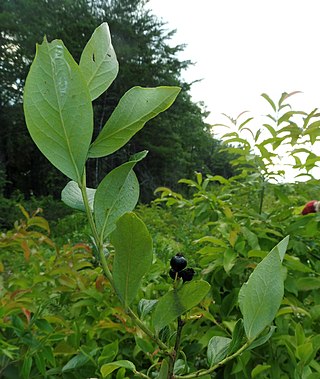
Vaccinium fuscatum, the black highbush blueberry, is a species of flowering plant in the heath family (Ericaceae). It is native to North America, where it is found in Ontario, Canada and the eastern United States. Its typical natural habitat is wet areas such as bogs, pocosins, and swamps.
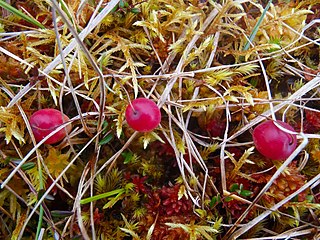
Vaccinium microcarpum is a species of flowering plant belonging to the family Ericaceae.
Titanotrichum is a genus of flowering plants belonging to the family Gesneriaceae.



















